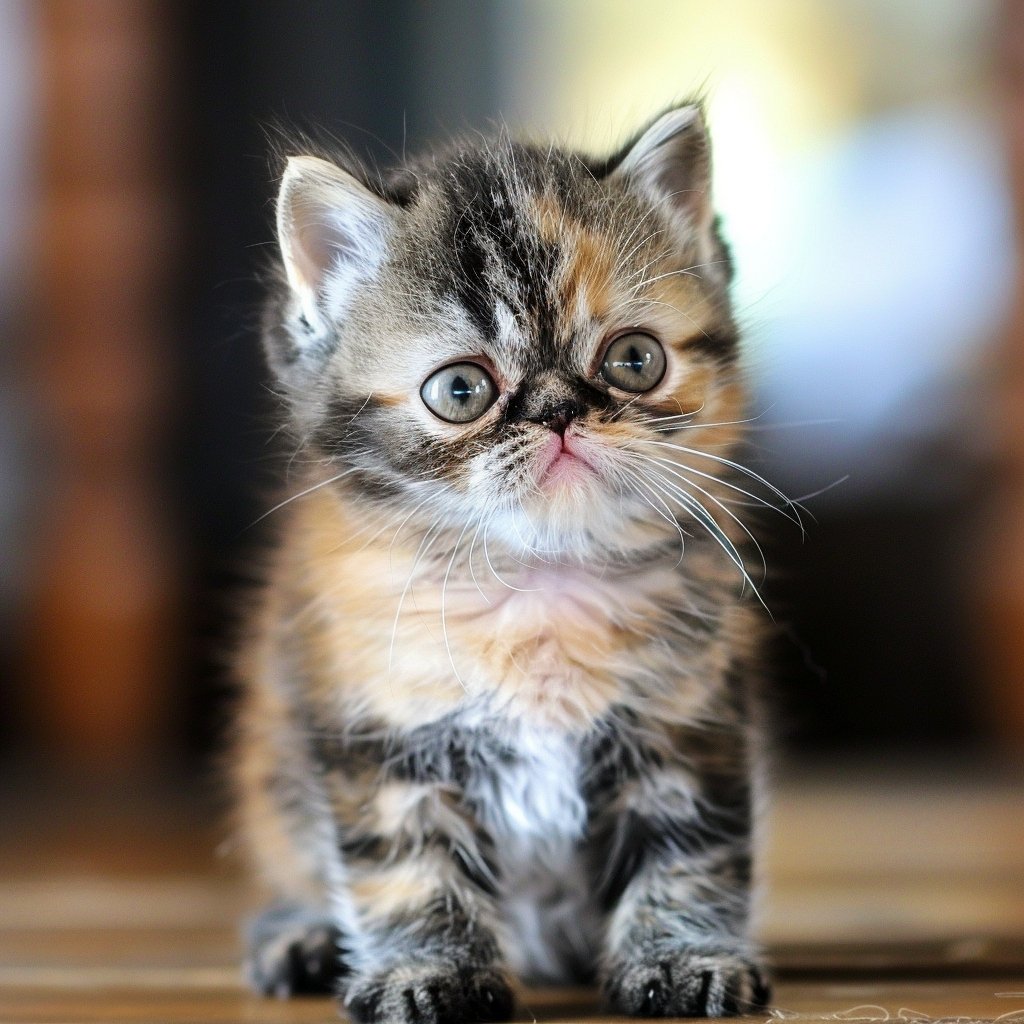Fluoxetine, commonly known as Prozac, is not just a human antidepressant; it can also be prescribed for cats facing behavioral issues.
This medication helps improve your cat’s emotional well-being by adjusting serotonin levels in the brain, making it effective for conditions like anxiety and aggression.
While the idea of a cat on medication might seem unusual, many pet owners have found it to be beneficial for their furry friends.
As a cat owner, you may have noticed behaviors that seem out of the ordinary or distressing for your pet.
Fortunately, fluoxetine might be a solution worth discussing with your veterinarian.
Understanding the proper use, potential side effects, and safety considerations is key to helping your cat thrive while managing their behavioral problems.
Taking the step to consider medication for your cat is significant and deserves careful thought.
Always consult with your veterinarian to ensure the best care for your pet, and explore how fluoxetine may play a role in their path to a happier, healthier life.
Key Takeaways
- Fluoxetine can help manage anxiety and behavioral issues in cats.
- Always consult your veterinarian for proper dosage and safety.
- Understanding your cat’s unique needs is crucial in treatment decisions.
Understanding Fluoxetine
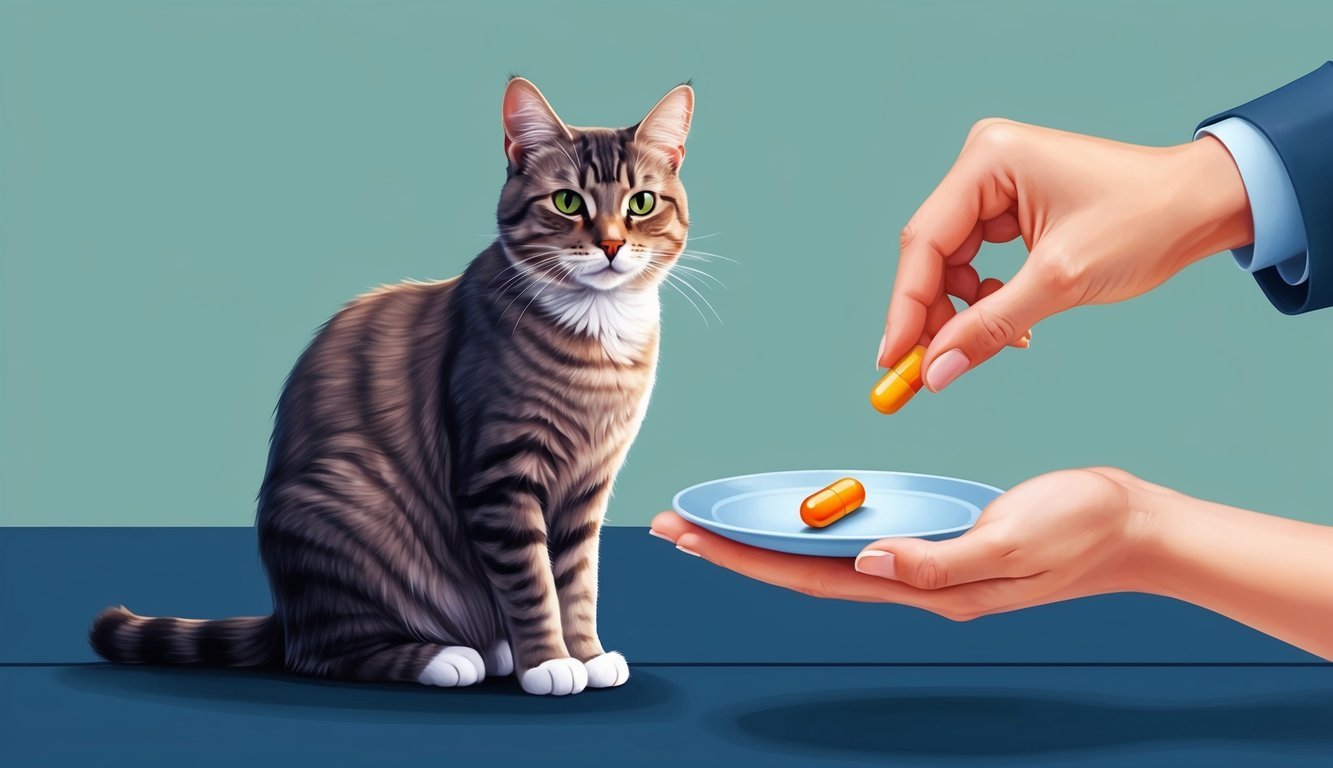
Fluoxetine is a medication commonly known for its use in humans but also plays a vital role in treating behavioral issues in cats.
As a selective serotonin reuptake inhibitor (SSRI), it helps regulate serotonin levels in the brain.
Here’s a detailed look at what fluoxetine is, how it works, and the forms available for your cat.
What Is Fluoxetine?
Fluoxetine is a prescription medication primarily used as an antidepressant in humans.
It is also known by the brand names Prozac and Reconcile when prescribed for pets.
This drug belongs to a class of medications called SSRIs.
SSRIs are designed to enhance serotonin levels, a neurotransmitter that plays a crucial role in mood regulation.
In cats, fluoxetine is utilized to address various behavioral disorders, including anxiety, aggression, and compulsive behaviors.
Your veterinarian may recommend this medication if your cat exhibits problematic behaviors that disrupt their well-being or your household.
Keeping an open line of communication with your vet can help ensure the best outcomes.
How Fluoxetine Works
Fluoxetine functions by blocking the reabsorption of serotonin in the brain.
This action increases the availability of serotonin in the synaptic space, ultimately enhancing mood and reducing symptoms associated with anxiety or depression.
When the levels of serotonin improve, you may notice your cat becoming calmer and more relaxed.
While it may not eliminate behavioral issues entirely, many cats show a significant improvement over time.
It’s essential to monitor your cat closely while on fluoxetine.
Each cat may respond differently to the medication, and adjustments in dosage may be necessary to achieve the best results.
Forms of Fluoxetine
Fluoxetine is available in various forms, making it easier to administer to your cat.
The most common formats include:
- Tablets: These are typically given once daily and can be administered directly or hidden in food.
- Capsules: Similar to tablets, these can also be given as treats or with food for easier consumption.
- Liquid: This form allows for precise dosing, which is particularly helpful for cats that are difficult to medicate.
Dosage varies based on your cat’s specific needs, typically ranging from 0.5 to 1 mg per kilogram of body weight.
Always consult with your veterinarian for the appropriate form and dosage for your cat.
Fluoxetine’s Uses in Cats
Fluoxetine is often used to address various behavioral issues in cats.
It can significantly improve your feline’s quality of life by targeting specific disorders.
Below are the main uses of Fluoxetine for treating common behavioral problems in cats.
Behavioral Disorders Treated
Fluoxetine is effective in treating a range of behavioral disorders in cats.
These include aggression, anxiety, and inappropriate elimination.
-
Aggression: If your cat displays aggression towards other pets or people, Fluoxetine may help modulate their behavior, making them more sociable.
-
Inappropriate Urination: For cats that urinate outside their litter box due to stress or behavioral triggers, this medication can assist in reducing these incidents.
Veterinarians often recommend Fluoxetine when behavioral modifications alone don’t yield results.
It can provide the necessary support for your cat to adjust better to their environment.
Fluoxetine and Anxiety Relief
Many cats suffer from anxiety, which can stem from various factors like changes in the home, loud noises, or new pets.
Fluoxetine acts as a selective serotonin reuptake inhibitor (SSRI), increasing serotonin levels in the brain, which helps alleviate anxiety.
-
Separation Anxiety: If your cat experiences distress when left alone, Fluoxetine can help them feel more secure during your absences.
-
Reactive Behavior: Cats that react negatively to environmental stressors can benefit from this medication as it helps reduce sensitivity to such triggers.
It’s important to monitor your cat’s response to the medication, as individual reactions may vary.
Benefits for Obsessive-Compulsive Behaviors
Fluoxetine is particularly helpful for cats showing signs of obsessive-compulsive behaviors.
These might include excessive grooming, tail chasing, or other repetitive actions.
-
Decreased Repetitive Grooming: If your cat is over-grooming to the point of creating bald patches, Fluoxetine can help break that cycle.
-
Improved Quality of Life: By addressing these compulsions, you’re allowing your cat to engage in more normal behaviors and enjoy a better overall life.
Incorporating Fluoxetine into your cat’s treatment plan can lead to significant changes in their behavior, offering them—and you—more peace at home.
Administering Fluoxetine to Cats
When it comes to giving your cat fluoxetine, it’s essential to focus on the correct dosage, specific needs of your pet, and the importance of veterinary oversight.
Here’s what you need to know.
Correct Dosage
Administering the right amount of fluoxetine is crucial.
The prescribed dosage will depend on your cat’s unique situation.
Generally, doses can vary between 0.5 mg/kg to 2.0 mg/kg once daily.
Keep in mind that starting with a lower dose may help minimize side effects.
It’s helpful to keep a record of your cat’s behavior and any side effects to discuss with your vet.
For liquid forms of fluoxetine, using a syringe can ensure accurate dosing.
Always follow your veterinarian’s guidance and avoid altering the prescribed amount.
Dosage for Cats
When determining the right fluoxetine dosage for your cat, consider their weight and specific behavioral issue.
For instance:
- A 5 kg cat might typically receive around 2.5 mg to 10 mg daily.
- A 3 kg cat usually requires 1.5 mg to 6 mg.
Each cat responds differently, so adjustments may be necessary.
Never share human medications with your pet, as formulations can differ significantly.
Always consult with your veterinarian before making any changes.
They will provide tailored recommendations based on your cat’s health and behavioral needs.
Monitoring by a Veterinarian
Regular check-ins with your veterinarian are essential during your cat’s fluoxetine treatment.
Your vet will monitor your cat’s response and assess any side effects.
It’s important to schedule follow-up visits, especially within the first few weeks of treatment.
Observing how your cat reacts can provide valuable information for dosage adjustments.
If your cat experiences side effects like increased anxiety or restlessness, contact your vet immediately.
They may recommend a dosage change or alternative treatment methods.
Always prioritize open communication with your veterinarian to ensure your cat receives the best care possible.
Potential Side Effects
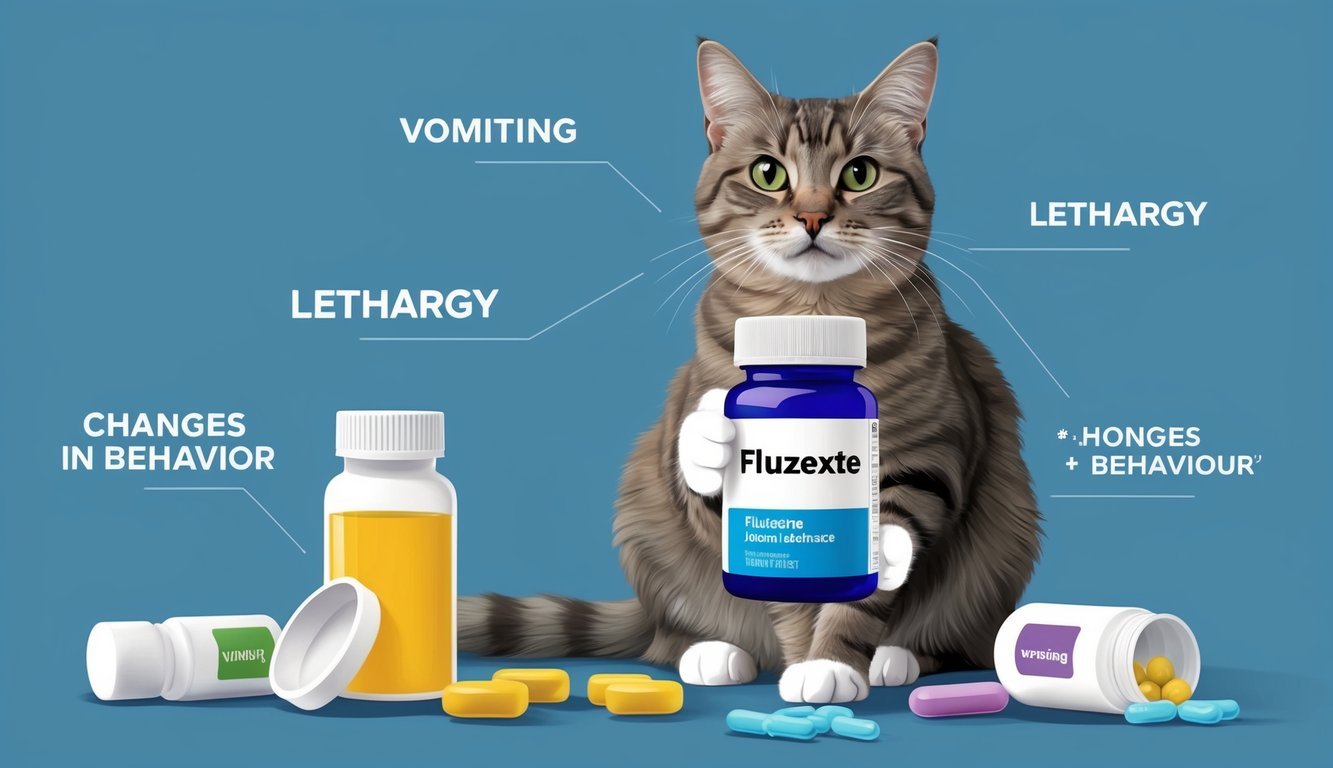
Administering fluoxetine to your cat can be beneficial but comes with potential side effects.
It’s essential to be aware of what these might be, how to manage them, and when to seek veterinary assistance.
Common Side Effects
Your cat may experience several common side effects when taking fluoxetine.
These can include:
- Vomiting: Some cats may have an upset stomach, leading to vomiting after dosing.
- Diarrhea: Gastrointestinal upset can lead to diarrhea, which may require attention.
- Decreased Appetite: Loss of interest in food is another common response to the medication.
- Restlessness: Some cats may show signs of increased agitation or pacing.
These side effects can vary in intensity among individual cats.
It’s important to monitor your pet’s behavior closely during treatment.
Managing Side Effects
If your cat experiences mild side effects, there are steps you can take.
Start by maintaining a consistent dosing schedule to help their body adjust.
Gradually introducing the medication can also help minimize gastrointestinal issues.
- Food Choice: Offering bland food or wet food may help with decreased appetite and vomiting.
- Hydration: Ensure your cat has access to fresh water to combat dehydration from diarrhea.
- Veterinary Guidance: Always consult your veterinarian if side effects persist or worsen.
Your vet may adjust the dosage or suggest alternative treatments to help manage these reactions effectively.
Recognizing Serious Complications
While many side effects are mild, serious complications can arise.
Be particularly vigilant for signs of Serotonin Syndrome, a potentially life-threatening condition.
Symptoms of this syndrome can include:
- Severe agitation
- Rapid heart rate
- Muscle spasms
If you notice any of these symptoms in your cat, it’s crucial to seek immediate veterinary attention.
Additionally, cats with liver disease may experience heightened risks associated with fluoxetine.
Monitoring liver function before and during treatment is advisable to ensure your cat remains safe while on the medication.
Safety Considerations and Contraindications
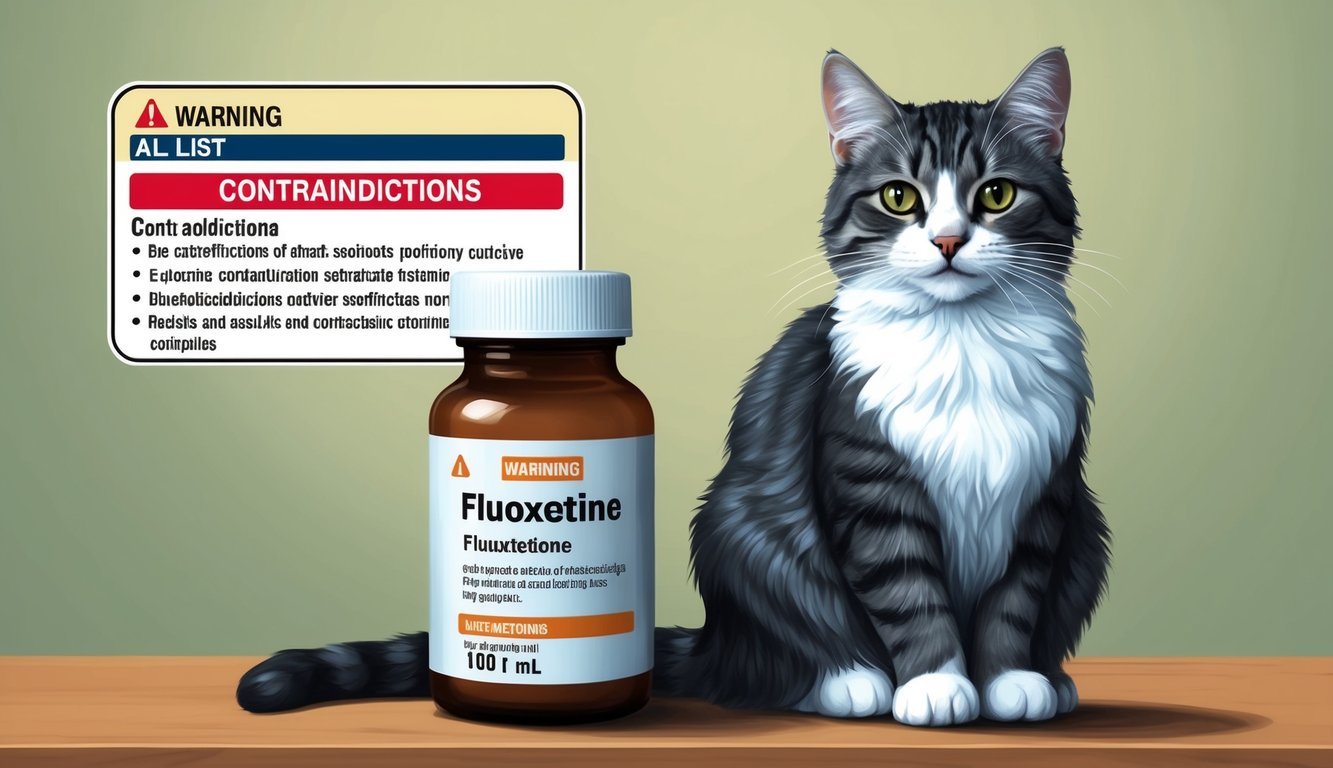
When considering fluoxetine for your cat, it’s crucial to be aware of potential drug interactions, specific contraindications, and when to reach out to your veterinarian.
Taking these precautions ensures your cat’s safety and well-being during treatment.
Drug Interactions to Avoid
Fluoxetine can interact with several medications, which may lead to increased side effects or diminished effectiveness.
Avoid using fluoxetine alongside monoamine oxidase inhibitors (MAOIs), as this combination can cause severe reactions.
Be cautious with medications like alprazolam and diazepam; the combination can heighten sedation, leading to lethargy in your cat.
If your cat is on insulin for diabetes, monitor their blood sugar levels closely, as fluoxetine may affect glucose regulation.
Always inform your veterinarian about any other medications or supplements your cat is taking.
Contraindications for Fluoxetine Use
Fluoxetine may not be suitable for every cat.
Cats with a history of known allergic reactions to SSRIs should avoid this medication.
Additionally, if your cat has severe liver or kidney disease, fluoxetine’s use could pose significant risks.
It’s also important to avoid giving fluoxetine to pregnant or lactating cats, as the effects on kittens can be harmful.
A thorough health evaluation from your veterinarian can help determine if fluoxetine is appropriate for your cat, considering these factors.
When to Consult the Veterinarian
Consult your veterinarian if your cat shows any concerning behavior or side effects after starting fluoxetine.
Signs like increased anxiety, hyperactivity, or irritability warrant immediate attention.
Regular check-ups can help monitor your cat’s response to treatment.
If you are considering starting fluoxetine or adjusting the dosage, a consultation is essential.
Always keep your veterinary team informed about any medical history or other medications your cat is taking for the safest treatment approach.
Alternatives and Supplementary Treatments
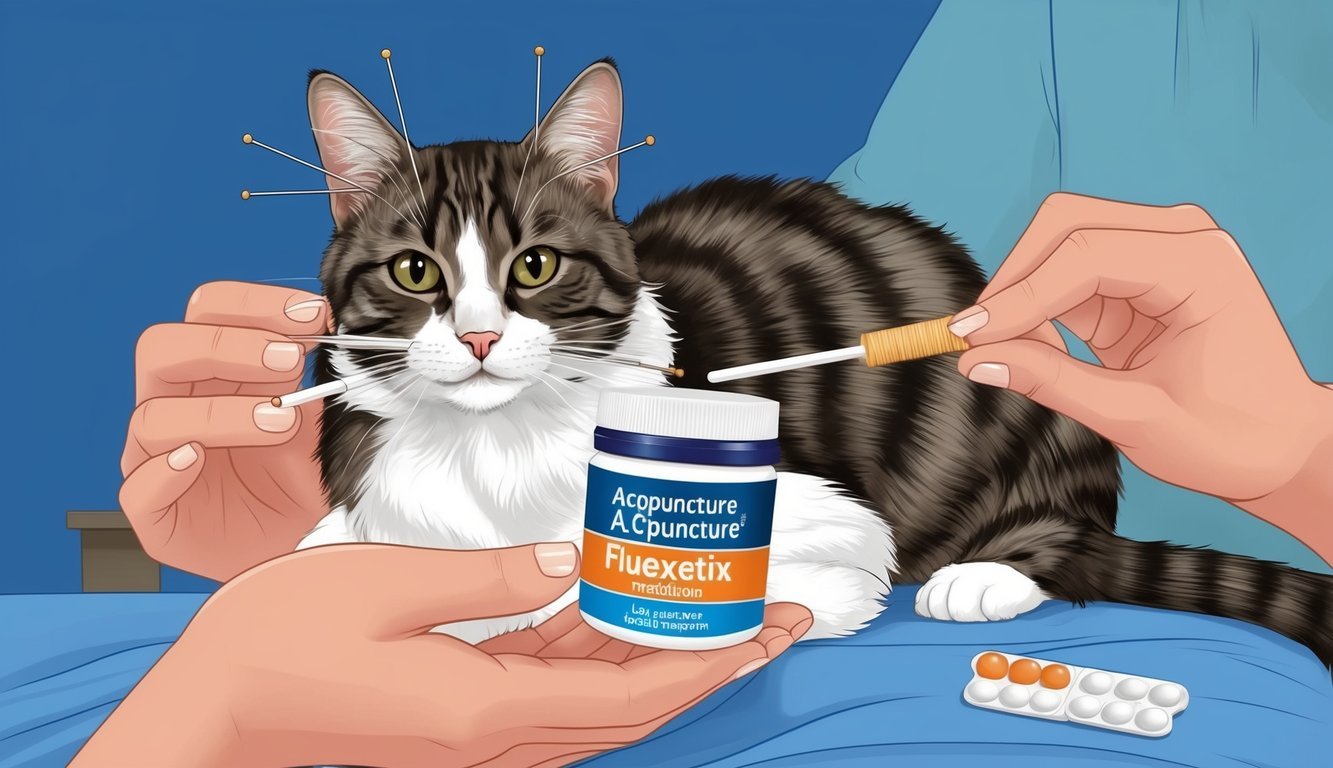
When managing your cat’s anxiety, you may want to explore alternatives to fluoxetine.
Understanding non-medication options and how to combine treatments can enhance your cat’s well-being.
Non-Medication Options
Several effective non-medication strategies can support your cat’s mental health.
You should ensure your space is calm and secure, minimizing loud noises and disturbances.
Here are a few approaches to consider:
- Feline Pheromones: Products like Feliway can create a soothing atmosphere. They mimic natural pheromones that help reduce stress.
- Enrichment Activities: Engage your cat with toys, scratching posts, and climbing structures. This encourages natural behaviors and reduces boredom.
- Routine Establishment: Keep a consistent schedule for feeding and playtime. Predictability can alleviate anxiety, especially for cats struggling with separation anxiety.
Implementing these strategies can create a supportive environment for your furry friend.
Combining Fluoxetine with Behavior Modification
Fluoxetine can be more effective when paired with behavior modification techniques.
This dual approach addresses both the chemical and behavioral aspects of anxiety.
Consider these behavior modification methods:
- Desensitization: Gradually expose your cat to stressors in a controlled manner. For instance, if your cat fears loud noises, start with low-volume recordings.
- Positive Reinforcement: Reward your cat for calm behavior during anxiety-provoking situations. Treats or praise can reinforce desired behaviors.
Involving a certified animal behaviorist may provide additional tailored strategies for severe anxiety cases.
By blending medication with behavior modification, you can support your cat in achieving a better mental balance.
Practical Tips for Cat Owners
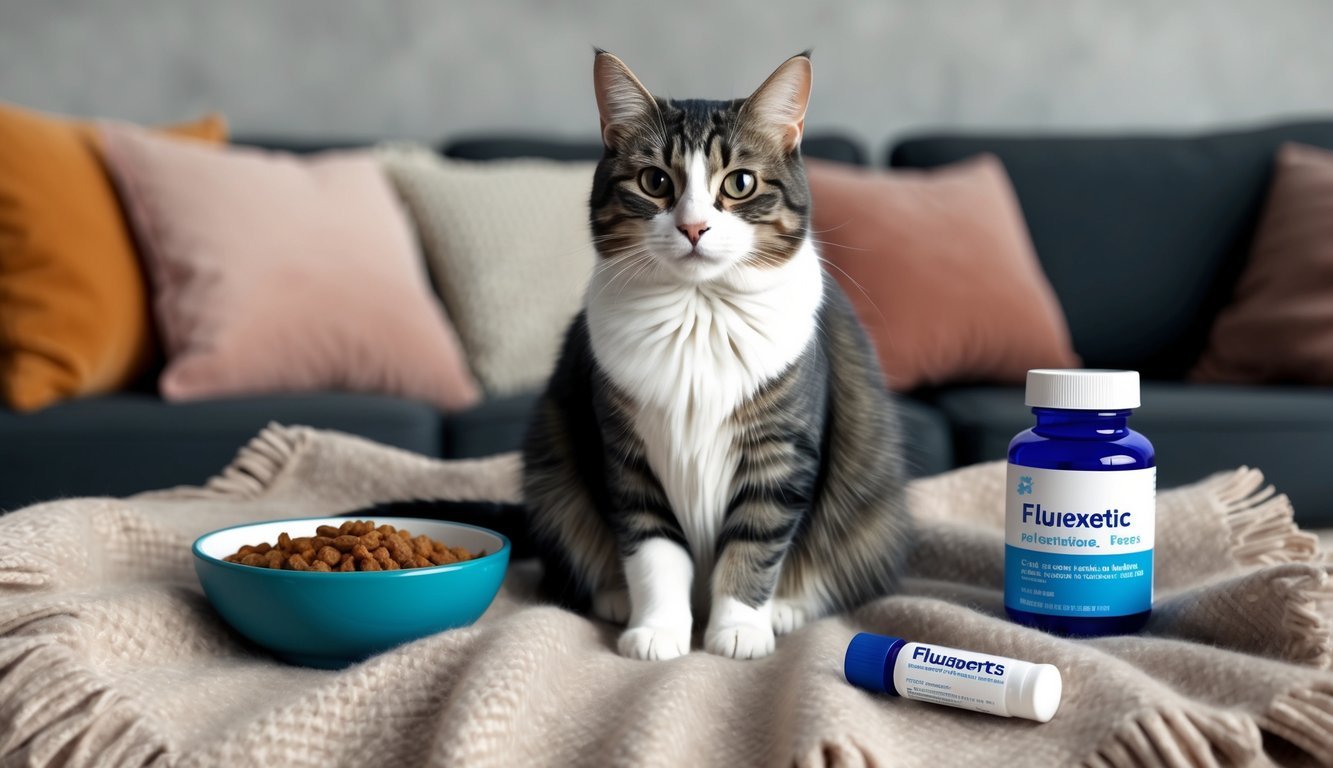
When managing fluoxetine treatment for your cat, proper handling and administration are crucial.
You should also be attentive to any changes in their behavior and health.
Here are some practical tips to assist you in the process.
Storing and Handling Fluoxetine
Store fluoxetine in a cool, dry place away from direct sunlight.
A bathroom cabinet or a drawer can work well.
Keep it out of reach of your cat to prevent accidental ingestion.
It’s important to keep the medication in its original container to avoid confusion.
If you need to travel, take the medication in its labeled bottle.
This ensures easy identification and helps you maintain the correct dosage schedule.
Always check the expiration date and dispose of any expired medication safely.
Your vet can guide you on how to do this correctly.
Proper storage ensures the medication remains effective and safe.
Training for Medication Administration
Administering fluoxetine to your cat can sometimes be challenging.
Here are a few tips to make the process smoother.
Choose the Right Time: Administer the medication when your cat is calm, ideally at the same time each day.
Cats thrive on routine.
Use Treats: You can mix the medication with a small amount of your cat’s favorite treat or wet food.
This disguises the taste and makes it more appealing.
Positive Reinforcement: After your cat takes the medication successfully, reward them with praise or a pet to reinforce good behavior.
This creates a more positive experience for both of you.
Observing Your Cat for Changes
Once your cat starts fluoxetine, monitor their behavior closely.
Some signs to watch for include changes in appetite, inappropriate elimination, or increased vocalization.
Behavioral Changes: You may notice reduced anxiety or compulsive behaviors like whining.
However, watch for any signs of irritability or hyperactivity.
Track Appetite: Keep an eye on their eating habits.
Fluoxetine can sometimes lead to increased or decreased appetite.
If you notice significant changes, notify your vet.
Documenting any changes can help your vet adjust the dosage as needed and provide a clearer picture of your cat’s response to the treatment.
Regular observation is key to ensuring your cat’s well-being.
Frequently Asked Questions

When considering fluoxetine for your cat, you may have a variety of questions regarding its effects, dosages, and overall utility.
Below are some of the most common inquiries that pet owners have about this medication.
What are the potential side effects of fluoxetine in cats?
Fluoxetine can lead to several side effects in cats.
Commonly reported effects include drowsiness, increased anxiety, and changes in behavior such as irritability or hyperactivity.
Some cats may also experience difficulty sleeping.
How is the correct dosage of fluoxetine for cats determined?
Determining the appropriate dosage of fluoxetine for your cat typically requires a veterinarian’s guidance.
They’ll consider your cat’s weight, age, and specific behavioral issues.
Monitoring your cat’s response is also important to adjust the dosage as needed.
Can fluoxetine be helpful for cats with aggression issues?
Yes, fluoxetine can be effective in managing aggression in cats.
It helps to regulate serotonin levels in the brain, which may reduce aggressive behavior over time.
Consistent communication with your veterinarian will ensure the best treatment plan.
Is there a standard price range for fluoxetine when treating cats?
The price of fluoxetine can vary depending on factors such as dosage and the pharmacy you use.
On average, a month’s supply may range from $30 to $60.
Always check with your vet or local pharmacy for the most accurate pricing.
What are some common experiences owners have with fluoxetine for their cats?
Many cat owners report positive changes in their pets after starting fluoxetine.
They often observe a reduction in anxiety-related behaviors and an overall calmer demeanor.
Each cat’s response can vary, so it’s essential to have realistic expectations.
How effective is fluoxetine in managing feline inappropriate urination?
Fluoxetine is often used to address inappropriate urination in cats, especially when stress or behavioral issues contribute to the problem.
Many owners find that it helps in reducing or eliminating the behavior when combined with behavioral therapy.

